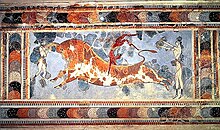A rare original carte de visite photograph circa 1870 of a Spanish bull fighter. A magnificent pose. Light wear otherwise good. An amazing early image!
Shipping discounts for multiple purchases. Credit cards accepted with Paypal. Inquiries always welcome. Please visit my other eBay items for more early theatre and historical autographs, photographs and programs and great singer, actor and actress cabinet photos and CDV's.
From Wikipedia:
Bullfighting is a physical contest that involves a bullfighter attempting to subdue, immobilize, or kill a bull, usually according to a set of rules, guidelines, or cultural expectations.
There are several variations, including some forms which involve dancing around or leaping over a cow or bull or attempting to grasp an object tied to the animal's horns. The best-known form of bullfighting is Spanish-style bullfighting, practiced in Spain, Portugal, Southern France, Mexico, Colombia, Ecuador, Venezuela, and Peru. The Spanish Fighting Bull is bred for its aggression and physique, and is raised free-range with little human contact.
The practice of bullfighting is controversial because of a range of concerns including animal welfare, funding, and religion. While some forms are considered a blood sport, in some countries, for example Spain, it is defined as an art form or cultural event,[1] and local regulations define it as a cultural event or heritage.[2][3] Bullfighting is illegal in most countries, but remains legal in most areas of Spain and Portugal, as well as in some Hispanic American countries and some parts of southern France.[4]
History
Bullfighting traces its roots to prehistoric bull worship and sacrifice in Mesopotamia and the Mediterranean region. The first recorded bullfight may be the Epic of Gilgamesh, which describes a scene in which Gilgamesh and Enkidu fought and killed the Bull of Heaven ("The Bull seemed indestructible, for hours they fought, till Gilgamesh dancing in front of the Bull, lured it with his tunic and bright weapons, and Enkidu thrust his sword, deep into the Bull's neck, and killed it").[5] Bull-leaping was portrayed in Crete and myths related to bulls throughout Greece.
The cosmic connotations of the ancient Iranian practice of Bull sacrifice are reflected in Zoroaster's Gathas and the Avesta. The killing of the sacred bull (tauroctony) is the essential central iconic act of the Iranian Mithras, which was commemorated in the mithraeum wherever Roman soldiers were stationed. The oldest representation of what seems to be a man facing a bull is on the Celtiberian tombstone from Clunia and the cave painting El toro de hachos, both found in Spain.[6][7]
Bullfighting is often linked to Rome, where many human-versus-animal events were held as competition and entertainment, the Venationes. These hunting games spread to Africa, Asia, and Europe during Roman times. There are also theories that it was introduced into Hispania by the Emperor Claudius, as a substitute for gladiators, when he instituted a short-lived ban on gladiatorial combat. The latter theory was supported by Robert Graves (picadors are related to warriors who wielded the javelin, but their role in the contest is now a minor one limited to "preparing" the bull for the matador.) Spanish colonists took the practice of breeding cattle and bullfighting to the American colonies, the Pacific, and Asia. In the 19th century, areas of southern and southwestern France adopted bullfighting, developing their distinctive form.

Religious festivities and royal weddings were celebrated by fights in the local plaza, where noblemen would ride competing for royal favor, and the populace enjoyed the excitement. In the Middle Ages across Europe, knights would joust in competitions on horseback. In Spain, they began to fight bulls.
In medieval Spain bullfighting was considered a noble sport and reserved for the rich, who could afford to supply and train their horses. The bull was released into a closed arena where a single fighter on horseback was armed with a lance. This spectacle was said to be enjoyed by Charlemagne, Alfonso X the Wise and the Almohad caliphs, among others. The greatest Spanish performer of this art is said to have been the knight El Cid. According to a chronicle of the time, in 1128 "... when Alfonso VII of León and Castile married Berengaria of Barcelona daughter of Ramon Berenguer III, Count of Barcelona at Saldaña among other celebrations, there were also bullfights."[8]
In the time of Emperor Charles V, Pedro Ponce de Leon was the most famous bullfighter in Spain and a renovator of the technique of killing the bull on a horse with blindfolded eyes.[9] Juan de Quirós, the best Sevillian poet of that time, dedicated to him a poem in Latin, of which Benito Arias Montano transmits some verses.[10]
Francisco Romero, from Ronda, Spain, is generally regarded as having been the first to introduce the practice of fighting bulls on foot around 1726, using the muleta in the last stage of the fight and an estoc to kill the bull. This type of fighting drew more attention from the crowds. Thus the modern corrida, or fight, began to take form, as riding noblemen were replaced by commoners on foot. This new style prompted the construction of dedicated bullrings, initially square, like the Plaza de Armas, and later round, to discourage the cornering of the action.[citation needed]
The modern style of Spanish bullfighting is credited to Juan Belmonte, generally considered the greatest matador of all time. Belmonte introduced a daring and revolutionary style, in which he stayed within a few centimeters of the bull throughout the fight. Although extremely dangerous (Belmonte was gored on many occasions), his style is still seen by most matadors as the ideal to be emulated.